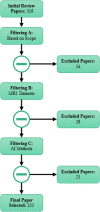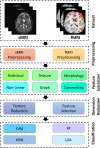Automatic autism spectrum disorder detection using artificial intelligence methods with MRI neuroimaging: A review
- PMID: 36267703
- PMCID: PMC9577321
- DOI: 10.3389/fnmol.2022.999605
Automatic autism spectrum disorder detection using artificial intelligence methods with MRI neuroimaging: A review
Abstract
Autism spectrum disorder (ASD) is a brain condition characterized by diverse signs and symptoms that appear in early childhood. ASD is also associated with communication deficits and repetitive behavior in affected individuals. Various ASD detection methods have been developed, including neuroimaging modalities and psychological tests. Among these methods, magnetic resonance imaging (MRI) imaging modalities are of paramount importance to physicians. Clinicians rely on MRI modalities to diagnose ASD accurately. The MRI modalities are non-invasive methods that include functional (fMRI) and structural (sMRI) neuroimaging methods. However, diagnosing ASD with fMRI and sMRI for specialists is often laborious and time-consuming; therefore, several computer-aided design systems (CADS) based on artificial intelligence (AI) have been developed to assist specialist physicians. Conventional machine learning (ML) and deep learning (DL) are the most popular schemes of AI used for diagnosing ASD. This study aims to review the automated detection of ASD using AI. We review several CADS that have been developed using ML techniques for the automated diagnosis of ASD using MRI modalities. There has been very limited work on the use of DL techniques to develop automated diagnostic models for ASD. A summary of the studies developed using DL is provided in the Supplementary Appendix. Then, the challenges encountered during the automated diagnosis of ASD using MRI and AI techniques are described in detail. Additionally, a graphical comparison of studies using ML and DL to diagnose ASD automatically is discussed. We suggest future approaches to detecting ASDs using AI techniques and MRI neuroimaging.
Keywords: ASD diagnosis; MRI modalities; deep learning; machine learning; neuroimaging.
Copyright © 2022 Moridian, Ghassemi, Jafari, Salloum-Asfar, Sadeghi, Khodatars, Shoeibi, Khosravi, Ling, Subasi, Alizadehsani, Gorriz, Abdulla and Acharya.
Conflict of interest statement
The authors declare that the research was conducted in the absence of any commercial or financial relationships that could be construed as a potential conflict of interest.
Figures









References
-
- Abdullah A. A., Rijal S., Dash S. R. (2019). Evaluation on machine learning algorithms for classification of autism spectrum disorder (ASD). J. Phys. Conf. Ser. 1372:012052.
-
- AGRE (n.d.). Available Online at: https://www.autismspeaks.org/agre (accessed July 19, 2022).
-
- Ahammed M. S., Niu S., Ahmed M. R., Dong J., Gao X., Chen Y. (2021). “Bag-of-features model for ASD fMRI classification using SVM,” in Proceedings of the 2021 Asia-Pacific Conference on Communications Technology and Computer Science (ACCTCS), (Shenyang: IEEE; ), 52–57.
Publication types
LinkOut - more resources
Full Text Sources

